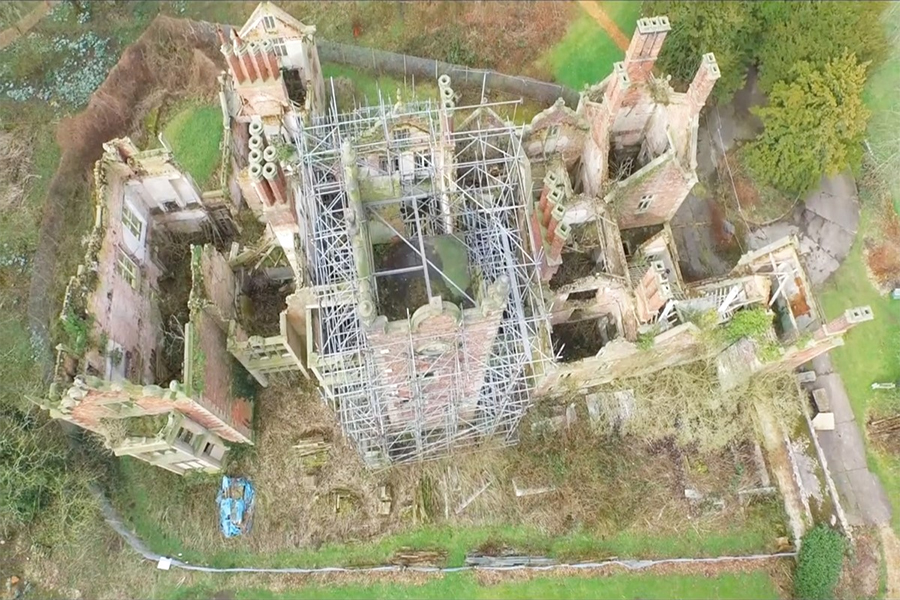A country mansion that was once one of Britain’s most at risk Grade II* listed buildings is enjoying a new lease of life, thanks in part to Welsh Slate.
It is Bank Hall, in Bretherton, Lancashire, which was removed from the Buildings at Risk register in October following its renovation.
Cwt-y-Bugail Dark Blue Grey roofing slates from Welsh Slate have been used over 1,000m2 of roof at Bank Hall, which has been converted into luxury residential accommodation and exhibition spaces.
The Welsh slates were specified for the £5.6million renovation on a like-for-like basis by architect Miles Pearson as the existing Welsh slates had been on the roof, in diminishing courses (as was the build method of the time), since the building was remodelled in the early 1830s.
“We chose the slate in conjunction with the National Lottery Heritage Fund’s team, who oversaw the project and felt a historic supplier was far more suitable than an overseas import,” says Miles.
The five-year project has converted the Hall into 10 apartments and two houses. In addition, the central four-storey Prospect Tower, a regionally significant architectural feature, now houses educational and exhibition spaces that are open to the public for two days a week. The public also have access to the outer gardens and walled garden.
Specialist sub-contractor RL Lovatt took nine months to complete the re-roof. The company’s team used 1F bitumen underlay and custom lead boxes to cater for the resident bat population. All abutments used lead soakers / flashings with stainless steel valleys and land valleys and conservation roof windows.
Contracts manager Andy Wilson says: “This project was quite the challenge due to time scales, the weather and the overall complexity of a job of this magnitude. Working with true Welsh Slate made all the difference – they are more durable, look fantastic and overall are much better to work with [than imported slate].”
Lovatt was supplied with the Welsh Slate products by distributor UK Slate.
Andy Wilson added: “Neil Purcell from UK Slate was instrumental in picking the correct slates for the job as he went to multiple meetings on site in regards to this and dropped a lot of samples off for the architectural team. His expertise in this was incredibly helpful to both the site teams and to ourselves.”
Bank Hall had been vacant and decaying steadily since 1971. It was the first building to feature on BBC Two’s Restoration series on television. Its restoration, thanks to a National Lottery Heritage Fund grant of £2.2million, was delivered by Chorley Borough Council in partnership with the owners, Heritage Trust North West, and developers Urban Splash and Next Big Thing Developments, specialising in difficult conservation building projects in the North West of England.
Architect Miles Pearson says: “Chorley planning and conservation were very proactive and welcomed the project. It’s gratifying for all stakeholders to know we saved the building.”
The earliest identifiable phase of the present building dates from the early 17th Century, although the house was extensively remodelled in the early 1830s. It is an early example of 19th Century Jacobean style by George Webster, an architect in Kendal, for owner George Anthony Legh-Keck. The main entrance porch on the north side, a drawing room wing at the west end and extensive service accommodation were all added at that time.
The Lilford family inherited the Hall in 1860. Although they never fully occupied it, they maintained it until the late 19th Century, when they decided to rent it out. During the Second World War it was used by the military and then handed back to the Ilford estate and used by the estate managers until it became derelict.
In addition to the house, Bank Hall includes 15 acres of gardens, an orchard and a copse. The orchard and copse are to be built on as they are the site of an enabling development of 23 homes, construction of which is due to begin in January.
It is more than 35 years since Save Britain’s Heritage drew attention to the plight of Bank Hall in its buildings at risk publication Silent Mansions. The Bank Hall Action Group (now Friends of Bank Hall) was formed in response to that and has campaigned to save the Hall. There is more about the renovation of the Hall on the National Lottery Heritage Fund website.


